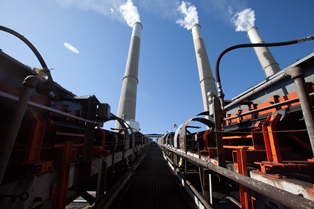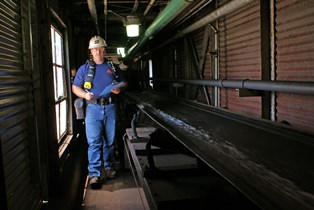Keeping Conveyors Running and Clean Helps Keep Coal-Fired Power Plants in Operation
Published: June 18th 2013
 [Neponset, IL] – If the turbine is the heart of the coal-fired power plant, the boiler/furnace is the stomach and the belt conveyors are the esophagus, keeping the power source well supplied.
[Neponset, IL] – If the turbine is the heart of the coal-fired power plant, the boiler/furnace is the stomach and the belt conveyors are the esophagus, keeping the power source well supplied.
Without the belt conveyor system, the fuel does not get where it needs to go, when it needs to get there. And of course, if the systems are not working as they should, there are consequences in production output and cost.
A key to plant efficiency is keeping those coal-handling conveyors running at peak levels. But like all mechanical systems, a belt conveyor runs more cleanly, safely and productively when it receives effective maintenance. This maintenance keeps performance levels at plant standards and avoids unscheduled outages. Effective maintenance requires proper planning, proper information and effective and safe labor.
One issue affecting coal-fired power plants is the worry about hazards from coal dust leading to fire and explosion.
 The problems from the creation, escape or accumulation of coal dust are now multiplied by the increased possibility of regulatory citations, fines and shutdowns, making it imperative that plants prevent the escape of coal dust. A key to minimizing the release of dust in coal handling is the proper maintenance of the conveyors and corresponding components, including belt cleaners, transfer point seals, dust curtains, dust suppression systems and dust collection systems. Proper adjustment and timely replacement of belt cleaners, for example, will minimize the problems with carryback releasing coal dust all along the conveyor.
The problems from the creation, escape or accumulation of coal dust are now multiplied by the increased possibility of regulatory citations, fines and shutdowns, making it imperative that plants prevent the escape of coal dust. A key to minimizing the release of dust in coal handling is the proper maintenance of the conveyors and corresponding components, including belt cleaners, transfer point seals, dust curtains, dust suppression systems and dust collection systems. Proper adjustment and timely replacement of belt cleaners, for example, will minimize the problems with carryback releasing coal dust all along the conveyor.
 As plants reduce their staff, some plants now entrust some or all of their conveyor equipment installation and maintenance work to outside contractors. Utilizing contractors allows plant personnel to focus on the plant’s core activities. This tactics keeps the management of maintenance in the hands of the plant, while outsourcing the actual labor.
As plants reduce their staff, some plants now entrust some or all of their conveyor equipment installation and maintenance work to outside contractors. Utilizing contractors allows plant personnel to focus on the plant’s core activities. This tactics keeps the management of maintenance in the hands of the plant, while outsourcing the actual labor.
Additionally, routine inspections can extend the life of the belt and conveyor components by keeping minor, easily corrected problems from turning into major and costly headaches. In the best operations, maintenance workers routinely walk the conveyor system looking for indications of potential trouble.
Conveyor inspections and maintenance can pose significant risks to employees because these activities bring the worker into close proximity with the conveyor system under potentially dangerous conditions.The worker is exposed to moving belts, rolling components and pinch points, all in an environment that is commonly dirty, distracting and noisy.
The best approach to safety is a training program that develops a healthy respect among the engineers, operations personnel and maintenance staff for the power of the conveyor and the risks inherent in its operation.
The goal is to provide maximum conveyor availability through quality work with minimal disruption to the production routine. Ironically, plants that cut corners on maintenance and cleaning activities for their conveyors and other systems can end up paying more over the long term in terms of environmental problems and service costs to cope with fugitive material in their plant.
Efficient and effective maintenance lowers costs, not just for the maintenance department, but the total operation. It produces benefits in operating efficiency, system availability and ultimately the plant’s bottom line.
Depending on the plant’s size, a 1% difference in system availability for a coal-fired power plant could be worth $1 million to $2 million dollars in annual revenue. An unscheduled conveyor outage or a component failure that decreases generating availability be even 1/10 of 1% is a significant loss.
In coal-fired power plants, efficient fuel handling on belt conveyors is essential to plant productivity. Maintenance that is properly planned with the proper information and performed safely and effectively, will keep those coal handling systems available.